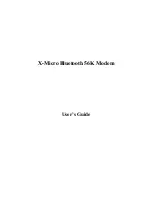
Chapter Five
Specifications
Man_805U Rev 1.8
Page
35
•
After each message is transmitted, a 805U unit will not transmit another message during
the transmit delay time. This could be used to allow a reply message to be received before
the next message is sent.
•
After a message is received, a message will not be transmitted during the receive delay
time. This could be used to delay a reply message until other messages have been sent.
Serial Port settings
The serial port settings should be selected to match the
host device. Different port settings may be selected for
different modules in the same system.
Serial data rate can be selected between 1200 and 115,200
baud. If you select a rate which is slower than the radio
rate, the 805U will automatically set transmission delay
parameters in registers S18 and S19 (refer section 3.8).
To disable this feature, deselect the “PLC Mode” box.
Then there will be no delay - data bytes will be
transmitted as soon as they appear in the input buffer.
The number of Data Bits can be selected as 7 or 8. The
number of stop bits can be 1 or 2. Parity can be none,
even or odd.
Flow Control
“Flow control” affects the use of the CTS and RTS signals on the RS232 port. These signals
can be used to prevent overflow of the input buffer or output buffer of the 805U. The settings
should be selected to match the host device. The options for this setting are :
!
“None” - The RTS signal from the host is ignored and the 805U sets the CTS signal
always on.
!
“CTS/RTS” - input buffer flow control
-
the 805U will reset the CTS signal when its input
buffer is full
-
presently there is no flow control on the output
side; if the host resets the RTS signal, the 805U
will still output data
!
“RS-485” - must be selected if using the RS485 port;
the 805U resets CTS when it is transmitting data.
If you want full duplex operation of the RS232 port, then
you need to select “None” or “CTS/RTS” - in the RS485
setting (default setting), the RS232 port will operate in
half duplex.
















































